|
Bristle/Fireworms Identification
FAQs 3
Related FAQs: Polychaete ID 1, Polychaete ID 2, Polychaete ID 4, Polychaete ID 5, Bristleworm ID 6, Bristleworm ID 7, Bristleworm ID 8,
Bristleworm ID 9,
Bristleworm ID 10,
Bristleworm ID 11,
FAQs: Worm Diversity
FAQs, FAQs
2, FAQs 3, & Worm IDs
1, Worm IDs
2, Worm IDs 3, Worm IDs 4, Worm
IDs 5, Worm IDs 6, Worm IDs 7, Worm
IDs 8, & Worm ID FAQs by Group/Phylum: Flatworm Identification ID, Nemertean, Proboscis, Ribbon Worm ID,
Nematode, Roundworm ID,
Nematomorpha,
Horsehair Worm ID, Acanthocephalans,
Thorny-headed Worm ID, Tubeworm ID, Hirudineans, Leech ID, Sipunculids, Peanut Worm ID, Echiuran Worm ID, & Bristle/Fireworms 1, Bristle/Fireworms 2, Bristle/Fireworms 3, Bristle/Fireworms 4, Worm
Identification, Polychaete Behavior, Polychaete Compatibility, Polychaete System, Polychaete Selection, Polychaete Feeding, Polychaete Disease, Polychaete
Reproduction,
Related Articles: Worms,
Polychaetes, Flatworms/Planaria,
|
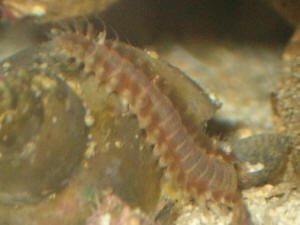
|
| ID this one tough guys ;) This guy is 11 inches long and
eats snails like pop corn. It has antennae like a grass hopper, a
body like a fire worm, legs like a millipede in addition to the
white ones) and a mouth like an eel. I also have a zip folder with
12-MB of other shots. <Hee hee! That's one big bad boy
bristleworm... do you want to know the family? I'd either
become it's agent or remove it to someplace safe or oblivion.
Bob Fenner> |
|
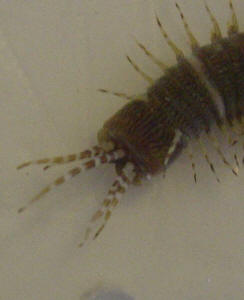
|
Fireworm ID (Hermodice carunculata).
7/5/07 Hello WWM Crew! <Hi Marc! Mich here.> As always,
thank you for this amazing website, it is very helpful! <Thank
you for your kind words!> I only have a single question tonight.
I've attached a picture of a fireworm I've seen in my tank
and was worried it might be the bearded fireworm (Hermodice
carunculata). I've seen pictures on the net that resemble this
worm but I wasn't sure if this really was H. carunculata. Could
you help me ID this worm? <This is definitely a fireworm and you
will likely want to carefully (Watch the bristles, they can contain
venom, which will make you rather unhappy if you come in contact
with.) remove it from your system as they are indiscriminate in
their feeding habits and can find many reef creature tasty snacks.
I do believe your ID is correct.> I know this worm is very
common in the Caribbean. I have 40 pounds (out of 140) of Brazilian
LR in my 125 gallons setup. It might have come from this rock.
<Certainly a possibility.> Don't know if you've
already seen this article <Mmm, nope, but will read. Read. Wish
I could read French too.>
(http://www.seashell-collector.com/Html/xeno/xeno%2099.pdf). H.
carunculata has a natural predator! <Mmm, likely several natural
predators.> Not that I would add a cone to a reef setup (nor
would I advise anyone to do so), <No, would certainly not be the
wisest thing. As you know, many varieties are poisonous and several
people have lost their lives to these snails.> but I found that
interesting and wanted to share. <Always appreciated.> Thanks
for your time <Welcome!> and keep up the good work,
<Will try! Mich>
Marc. |
|

|
Worm in a sand tube -- 06/14/07
Hello Crew, <Hi Carlos, Mich here.> After 10 years w/o a marine
tank I decided to dive back into the hobby. <Come on in the
water's great!> I just setup a 70 gal tank. I have one lone
damsel and about 30 lb of live rock (on my way to get more.
<Hopefully this new rock is fully cured.> A few days after
putting the rock in I noticed what appeared to be a thin walled tube
made up of sand coming from one of the rocks. The tube is made up of
some sort of slime and is clear except for a thin layer (1 grain
thick?) of sand. Yesterday I turned on the lights and caught what
appears to be a very small (barely visible) black worm scampering back
to the rock inside the tube. I've seen it twice now. It seems to
come out at night then back to the rock when the lights go on. Can you
identify? <Sounds like a type of feather duster worm, likely a
member of the family Sabellaridae.> Is it bad for the tank?
<Nope. More here: http://www.wetwebmedia.com/feather.htm > Thanks
in advance for your help. <Welcome! Mich>
Carlos
Saltwater "worm" question??
5/29/07 Hi there. <Hi Jimmy, Mich here.> I've had my
tank for 2 months now, and I have noticed 3 "worm"
looking things in the small rocks at the bottom of my tank, that
are probably about 1/2" long and thin, and have small spikes
all around them on the edges, and when I looked closer, I could see
blood, I'm guessing, pumping from the top of their bodies to
the bottom. I'm wondering what the heck are they and are they
harmful and any information at all?? <Sounds like some type of
bristleworm, most are harmless scavengers that help to keep the
tank clean. Some photos and more info here and the related links in
blue: http://www.wetwebmedia.com/polychaetes.htm I would avoid
handling these worms. And if you must, then wear gloves. The
"spikes" called chaetae can cause problems ranging from
irritation to severe pain should you get stuck.> I tried to take
a picture, but it won't turn out and I can't turn the flash
off from my camera. <...Now where did I put that camera manual?
What's that quote about a thousand words?...> Thanks in
advance.
<Welcome! Mich>
-Jimmy |
Re: saltwater "worm" question?? Now
with picture 5/29/07 <Hi Jimmy, Mich with you
again.> I wrote earlier about worm looking things in my tank,
and I finally got a picture to turn out, and here it is. Can you
verify what they are please? <Yes, They appear to be
bristleworms.> There's 3 in the picture, <I see them.
Thank you for the photo, it is helpful.> thank you!
<Welcome!> |
|

|
| Malu anemone died... Polychaete ID,
comp... 5/9/07 Hi Crew, <Hazel> I love your
site and have found many answers to my questions. Someone always
has had the problem before me it seems. I would like to
know what this is though. I have a 200L marine tank and
this worm has been in it from the start. He must have
been in the live rock. <Yes, very likely> I thought that he
was about 8 inches long but he is over 24 inches as I found out
when I removed him a few days ago. Something was eating the
Cladiella coral and the malu anemone in the front left
corner of my tank and he lived in those rocks behind that area. I
am not sure he is the problem as he only seems to eat dead items
despite his enormous size; <Mmm, yes> I have him in a spare
tank at this moment so I can observe him. (He is very interesting
because of his size and he loves muscles and eats small dead fish
as well as flake food) I do not want to kill him. In my
regular tank I saw a small red bristle worm steal some food from
the malu anemone as the anemone was beginning to show signs of
damage. I have not caught this yet. Too quick for me.
<Can, could be baited, trapped...> My tank is water salinity
1.025, ammonia 0, Nitrites 0, Nitrates 0, PH 7.8 am and slightly
higher pm. Calcium 380 - 390, I use RO water and mix the
salt, change 15% water every Friday, and keep mostly soft corals.
The tank is a Berlin system with a skimmer and filter at the back
of the tank and 3 pumps moving the water around, two at the bottom
and one two thirds of the way up. There is a grill where the water
flows to the back part of the tank into the skimmer etc. I have
recently added a superb Catalaphyllia which was about eight inches
away from the anemone and from the Cladiella, and wonder if that
gives off any poisons in the current. <Of a certainty, yes>
Could it be that it is blocking the water flow from the area as
they are in the front corner? <Perhaps... circulation matters
are too-little discussed in our interest> The Catalaphyllia is
eating well and is out all day. The clowns have moved in
as the anemone has now disappeared. Above the sand, on the first
level of rock I have a Tubastraea which is growing very well and
has new heads growing from the sides of the existing
heads. I feed this every night, sometimes brine shrimp
or Mysis and sometimes parts of defrosted frozen fish from local
marine store. Also small pieces of
shrimp. This has been very good, always open at 7pm
ready for its dinner. This has been above and to the right of the
malu anemone for some months. Could this give off some
chemical that hurt the malu? <Yes> I have one yellow tang,
one coral beauty, one mandarin, five blue Chromis, one fairy
wrasse, one chalky goby, three pyjama cardinals and a breeding pair
of Banggai cardinals (had babies few weeks ago) and the
two clowns. The tank is quite peaceful. I have a flame scallop and
two hermit crabs, and two Lysmata amboi and three Lysmata
wurdemanni, plus a long spined urchin (recent addition for baby
cardinals to hide in). Babies disappeared soon after being born and
the one I caught died later in the breeding net. I use PhosBan to
keep the phostrogen levels down as I feed the fish and the corals
on a daily basis. I have kept tropical fish for
many years but only had marines for a year or so. I have
read up on the marine tanks, on reefs critters corals etc and
spoken to lots of local stores people but there is so much to
learn, can you help me with this problem as I would love to buy
another anemone, but only after I have the right conditions for it
as I hate to see it die. Thanks for reading this Best regards Hazel
<Please read here re this Polychaete, Hermodice canunculata:
http://www.wetwebmedia.com/polychaecompfaqs.htm and the
linked files above... And take a jaunt through our page re using
WWM: http://www.wetwebmedia.com/WWMAdminSubWebIndex/question_page.htm
re Catalaphyllia compatibility, other questions you have/pose. Bob
Fenner> |
|
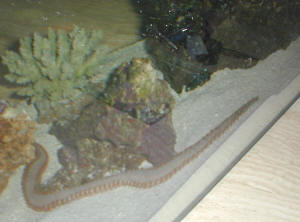
|
| Bristleworm? Mmm, Polychaete... more
likely Eunice spp -- 4/10/07 <Hello, Mich here.>
Just wondering if this is indeed a bristleworm. <Is a Polychaete
worm, but I suspect is something more along the lines of Eunice
spp. Some are beneficial scavengers others can be highly
predatory. I think I would consider
removing.> It is very, very small. <And hopefully
stays that way! some Eunice worms can get very, very
large!!!> And if you wanted to use either picture on your site
feel free. <Thank you.> I like to help in any way I can.
<You have by sending your query!> Your site is wonderful.
<Thank you for the kind words! -Mich> |
|
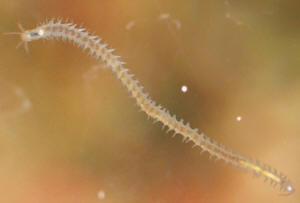
|
Confusing worms? Reading, on... WWM
-- 03/18/07 Hey guys, <Josh> A while back I wrote you about a
small oyster toadfish that I rescued from a friend. Your advice was
much appreciated, and now he is happily living in a 40 gallon tank (at
least until I can afford a bigger one ;). He is actually making his fog
horn like mating call all the time! <Neat!> (My friend had never
heard it before and was jealous). Anyway, I am doing an internship with
a local aquarium <Ahh, very good> and they donated some small
brittle stars to my tank to help stir the substrate. <Nice> I
apparently also got some worms with it and I really don't know what
they are.. maybe some kind of fireworm?? <Polychaetes of many types
are very common. See WWM re> They are about an inch in length and
orange-red. They appear not to have any bristles and bury in the
substrate. When they do, they send out 3-4 long hair like red tentacles
that just sort of sit on the substrate and move with the water flow.
They don't appear to move much around the tank, if at all. I have
two turbo snails and the toadfish and would like to eventually make it
more of a reef tank. Are these worms harmless? <Most are> Should
I get rid of them now before they multiply or just leave them? <The
latter for now> Which brings me to my second problem. I can't
get the nitrate levels down. I have done many water changes up to 70%
and it brings the levels down slightly, but within a few days they are
back at the highest level <Yes... Batrachoidids are big feeders,
waste makers...> I can read with my "Red Sea Marine Lab"
test kit. I don't have a protein skimmer, just a standard marine
filter which pulls the water over a sponge like filter, through a bag
of carbon and then over some rocks the bacteria are growing on. A
friend suggested getting rid of the filter, but I clean it every other
day so I don't THINK that's causing the problem.. so the only
thing I could think of was maybe there is stuff decaying in the
substrate, hence the desire for worms and brittle stars. Think that
might be the problem? <See WWM re Nitrates... the search tool,
indices...> This tank is about 2 months old without any hermit
crabs, but the nitrifying bacteria should have become more than
established by now right? <You need their complement of denitrifying
bacteria... a place for these to be...> oh yeah, and I am very
careful about how much I feed my fish so there is not excess food in
the water. Thanks for your help!! Josh <Be reading. Bob
Fenner>
| Soft Coral, worm, algae ID
12/6/06 Dear Crew, I was wondering if you could help me
identify my new soft coral. It was sold to me as a Sarcophyton sp.,
but it looks more like a Sinularia sp. to me. I have attached
pictures for reference. <Is not a Sarcophyton for sure... Likely
is a Sinularia species... definitely a Alcyoniid> On another
note, I was watching my tank the other night and I noticed what I
believe are worms, possibly bristle worms, swimming through the
tank. They were swimming rather quickly with a cork-screwing
motion. <Good description...> I couldn't find any
reference to similar behavior, so I was curious about it. I have
also attached a picture of one of the worms. (I couldn't get a
picture of one swimming, so it is a picture of the worm on the
glass.) <Is an Errantiate polychaete (there are thousands of
species) of some sort> Also, I am having trouble with, but I am
not sure what type it is. I can't find anything that looks
similar to it. It grows all over my live rock and the glass of the
aquarium. I have also attached a picture as a reference. <Are
Blue-greens... Cyanobacteria...> My parameters are as follows:
55 gallon tank with 120 watts NO fluorescents Temperature:
79° F Nitrite, Nitrate, Ammonia, Copper: 0 ppm pH: 8.2
dKH: 10° Calcium: 550ppm <Way too high...>
Specific Gravity 1.026 Weekly 10% water changes with RO water.
Top-off twice daily with RO water. (About a quart of a water each
time.) Thank you for your time, Daniel <Mmm, please do take a
read on WWM re the groups, situation mentioned above... Bob
Fenner> |
|
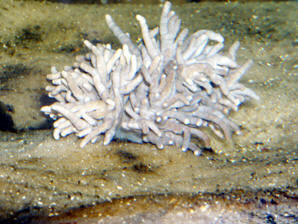 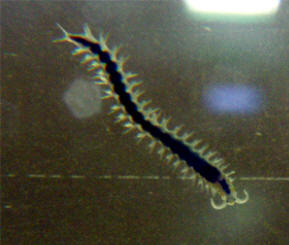
|
|
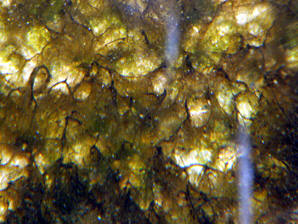 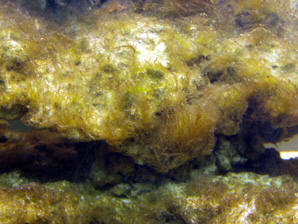
|
| Crazy Worm? -- 02/27/07 I just got home to my
poor stressed tank and see something very strange on my clump of
dish coral. Two or three corals have developed close
together and it looks like some type of segmented worm going from
one to the other. Or could they be transferring
material? I am not sure if I should get it with tweezers
or not. I am sending a photo along. Thanks, Cathy
<<Well Cathy I can't really make anything out from the
photo, but this doesn't look like a worm to me...it appears
more to be mucus/excrement...and likely nothing to be concerned
about. Regards, EricR>> |
| Re: Crazy Worm? -- 02/28/07 Thanks again
Eric. <<Hi Cathy!...quite welcome>> I just wanted to
follow up. In fact, it was a brown segmented worm.
<<Ah, thank you for this...I did not get that from the
photo>> Have you ever heard of this before.
<<Mmm...many, many, MANY species of worms about (in excess of
10,000 I do believe). Do you have any (missing?)
fan/tube worms? Possibly one of these exited its
parchment tube and was actually being consumed by the coral rather
than the other way around>> It was as if it was going into
the mouth of my dish coral. <<Yes...did see this>> I
did yank it out and had it move around awhile. I could
not identify it. <<Too bad you didn't take/send a
close-up pic>> Seemed more like an earthworm than bristle
worm. <<From what I could discern, yes, would agree it was
not a bristle worm>> Thanks again for all your
advice. <<Always happy to try to
assist. EricR>> |
|
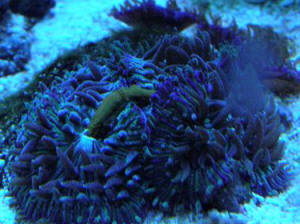
|
Identification help,
Polychaetes 2/25/07 We need help identifying this worm
that came in our Caribbean live rock. We have searched your
sight extensively, and on the web as well, and have not found it.
<There are many possibilities...> It is not a bristle
worm. We found two pictures that looked similar, although
not exactly the same. One was called a polychaete Typosillis and the
other was called a polychaete Hesionid. <A genus and family, e
pluribus unum...> We were not able to find any information other
than pictures on those 2 worms, however. It moves very much like a
centipede and has a very distinctive pattern. We are trying to find out
if it is ok to put it in the tank, or if it's a "bad
guy". Can you help us? Here are the links to the Photo
Bucket pictures. <These are "not available..."> Thanks,
Susan & Lisa <I would be careful in handling these worms... the
lateral processes (parapodia) have sharp structures and sometimes
poison sacs associated with them... (use tongs or a net)... but unless
they're very large and/or numerous they can be likely placed with
your other livestock. Should they prove troublesome, polychaetes are
almost always easily baited/trapped, removed. Bob Fenner>
|
|

